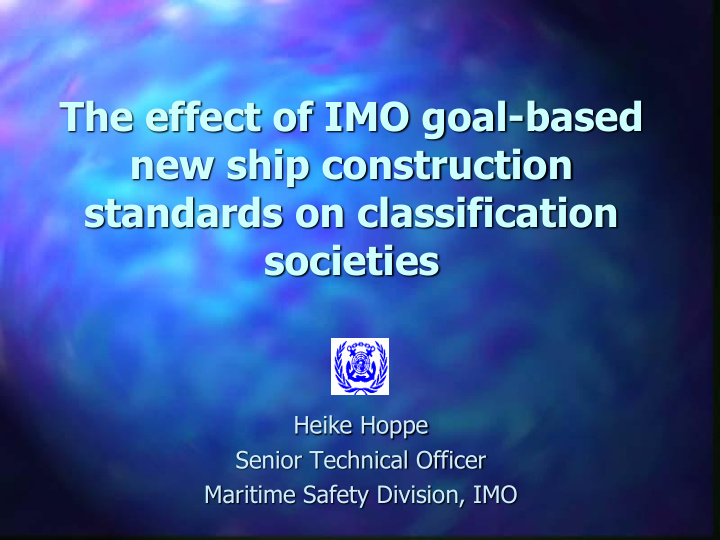



The effect of IMO goal-based new ship construction standards on classification societies Heike Hoppe Senior Technical Officer Maritime Safety Division, IMO
IACS Non-governmental organization in consultative status with IMO since 1969
IMO and classification society requirements SOLAS regulation II-1/3-1 “ In addition to the requirements contained elsewhere in the present regulations, ships shall be designed, constructed and maintained in compliance with the structural, mechanical and electrical requirements of a classification society which is recognized by the Administration in accordance with the provisions of regulation XI/1 or with applicable national standards of the Administration which provide an equivalent level of safety. ”
MSC/Circ.788 A.739(18) - Guidelines for the authorization of recognized organizations acting on behalf of Administrations A.789(19) - Specifications on the survey and certificate functions of recognized organizations acting on behalf of the Administration MSC/Circ.710 - Model agreement for the authorization of recognized organizations acting on behalf of the Administration
What does goal-based mean? Goal-based: “People shall be prevented from falling over the edge of a cliff.” Prescriptive: “You shall install a 1 metre high rail at the edge of the cliff.”
History C 89 (2002) First proposal MSC 77 (2003) New item C 90 (2003) Strategic Plan A 23 (2003) Long-term work plan MSC 78 (2004) 5-tier system agreed MSC 79 (2004) Key issues agreed
Basic 5-tier system Tier I Goals (safety objectives) Tier II Functional requirements Tier III Verification of compliance criteria Tier IV Technical procedures and guidelines, classification rules, industry standards Tier V Codes of practice and safety and quality systems for shipbuilding, ship operation, maintenance, training, manning, etc.
GBS basic principles broad, over-arching standards that ships are required to meet during their lifecycle; the required level to be achieved by the requirements applied by class societies, other ROs, Administrations and IMO; clear, demonstrable, verifiable, long standing, implementable and achievable, irrespective of ship design and technology; specific enough in order not to be open to differing interpretations
Tier I goals adequate strength, integrity and stability constructed of materials for environmentally acceptable dismantling and recycling providing for safe access, inspection and proper maintenance fit for envisaged operating and environmental conditions lasting for a specified design life
Tier II - Functional requirements Design II.1 Design life II.2 Environmental conditions II.3 Structural strength II.4 Fatigue life II.5 Residual strength II.6 Protection against corrosion II.7 Structural redundancy II.8 Watertight and weathertight integrity II.9 Design transparency
Tier II - Functional requirements Construction II.10 Construction quality procedures II.11 Survey
Tier II - Functional requirements In-service considerations II.12 Maintenance II.13 Structural accessibility
Tier III – Verification Rules for Rules, not for ships Verification authority Verification process Acceptance criteria Guidelines for verification
Tier IV Technical procedures and guidelines, classification rules and industry standards IMO requirements Administration requirements Class requirements
Tier V Codes of practice and safety and quality systems for shipbuilding, ship operation, maintenance, training, manning, etc. Industry standards Industry practices
Verification and class 4 basic steps: rules of class meet GBS ship design meets class rules ship construction meets class rules ship meets rules throughout life
Verification process IMO Group of Experts Verification criteria Review/audit of class rules Review/audit report Class rule changes
IACS CSR IACS Common Structural Rules for Bulk Carriers IACS Common Structural Rules for Double Hull Oil Tankers
Recommend
More recommend